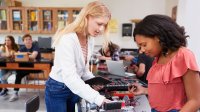Physics Design Challenges Based on Big Ideas
A strategy for designing classroom competitions that encourage all students to learn from each other as well as from their own trial and error.
Your content has been saved!
Go to My Saved Content.When teachers use competitions in class, they often design one-off competitions that challenge students to see who can build the tallest tower or who can answer the most questions correctly on a game show. In these setups, usually the most talented students win, which can reinforce how students see themselves and stifle engagement. The brightest students receive all kinds of rewards (internal and external) and will usually come back and try hard again next time. The students who don’t excel at these competitions will often do poorly, feel bad, and think they are incapable.
In order to preserve the benefits of competition while encouraging all students to continue trying their best, I’ve designed challenges based on big ideas in my high school physics class. These rest on the concept of “redesign,” which occurs at the midway point of multiweek competitions.
These are the guidelines I use to create fun, inclusive, useful, and deep-thinking competitions:
- Give students a crash course ahead of time to build a baseline of knowledge.
- Set parameters so there is a spectrum of success.
- Set a first deadline for initial testing.
- Let kids redesign and improve.
- Spread the work days out over several weeks, having more traditional content days in between so that kids can think of other ideas and not get fatigued.
Competitions Over Big Ideas
The assignment: In physics this year, I created a six-week competition where I challenged the students to see which group could build a Lego EV3 robot to travel 15 meters in the least amount of time. This was completed early in the year, when physics is doing forces and motion. The kids had used Lego Mindstorms in a few previous labs, so they were somewhat familiar with the robots and the software.
In the beginning, students tried lots of things. Some used gears; some focused on making them look like a car. Many found that even making the robots go straight was kind of hard. They built the robots too tall, so they fell over. The students kept moving forward and gathering data.
As long as they built a robot that went the 15 meters and kept trying, they got full credit, so the grade was not the motivator. Groups were motivated, however, to keep innovating to decrease the time it took their robot to travel. We worked on Fridays and whenever they got done with regular class work.
The pause: About three weeks in, we paused and put numbers up on the wall for students to see. Each group could see where they were in the standings compared with the other groups. Then they could see what others were doing and make changes.
Studying what worked: All of the students looked to the groups with the fastest robots to see what they were doing well. They began to notice which physical properties mattered: gearing, quality construction, and low center of mass made a huge difference, while aerodynamics seemed to make no difference at all. On the class website, I posted videos about gearing and chassis construction, and the class realized that the best groups were focused on that element of construction. During work time, I circulated around the groups and talked to them. Groups that were struggling got a little extra nudge. I encouraged the kids to talk to other groups about what worked as well.
The redesign: The redesign process transforms this competition into an equity practice, increasing thinking and understanding for everyone. After the midpoint check-in, students spent the rest of the class time improving on their own design. This takes extra time, but students whose robots were a little bit slower had the chance to redo, and groups with fast robots could try new things to improve as well.
The importance of the redesign step can’t be overstated. So much critical thinking, problem-solving, grit, and fun happens in this step. Because groups are also competing against themselves to lower their own time, the top groups continue to work for improvements.
How Effective Is the Redesign Step?
After our robot challenge, I wanted to know how much students were able to put into practice what they were learning in the redesign step. This time, I challenged students to design a sled that could pull the most weight. We were studying work and energy, and the sled-pulling competition challenged students to incorporate ideas of friction, force, distance, and simple machines.
Different groups used different approaches, including pulleys, gears, adding more wheels, adding mass for more friction on the car, etc. Again, halfway through, we paused to see where everyone was, learn from each other, and engage in redesign. Amazingly, between the initial trial and the redesign phase, the lowest-performing three groups were able to improve by an average of 866 percent. The top group innovated as well, raising the amount of weight pulled by 42 percent. Nearly every group showed significant improvement.
Although these competitions take time, and can cause student frustration when things don’t work right, I think they’re worth it. Science is much more than worksheets and problems: Through these competitions, students not only learn more about the course content from the trial and error over several weeks but also learn how to manage frustration and iterate ideas.
Students enjoy these competitions—they tend to focus on beating their own best time, rather than on who beat them. When I talk to students later in the year or the next year, this is the part they tend to focus on.
